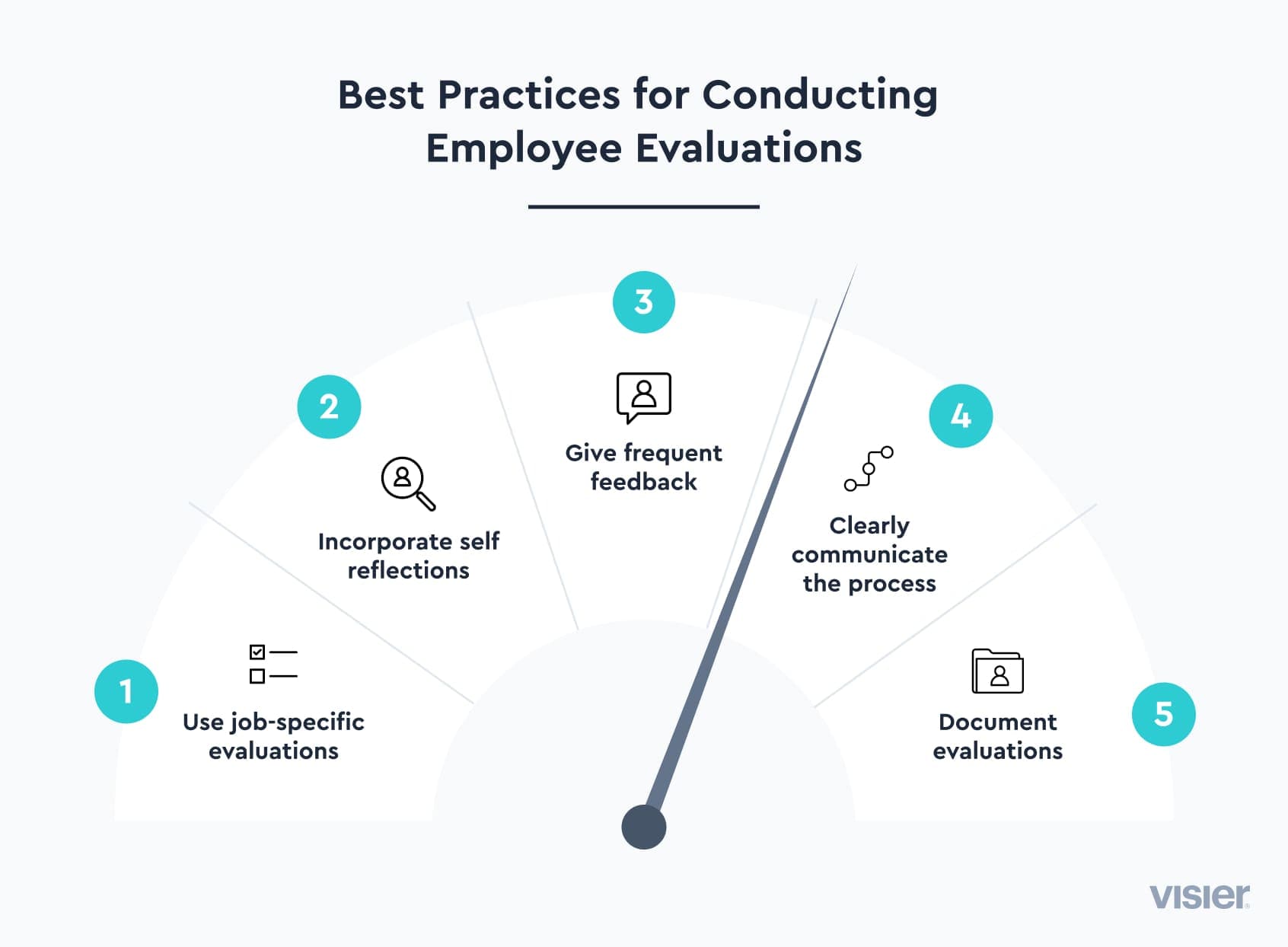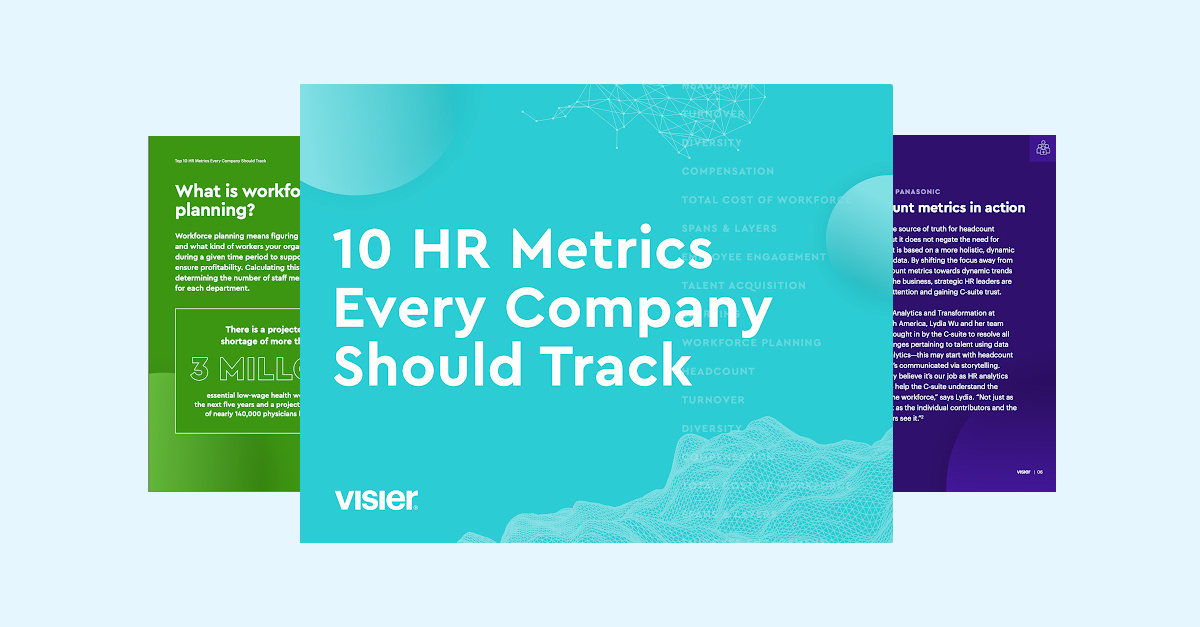MANAGER EFFECTIVENESS
Complete Guide to Employee Evaluations
Employee evaluations create alignment between managers and employees, setting clear expectations for performance. Read this guide to learn more.
Take a tour
Table of contents
What is employee evaluation?What are the benefits, pros, and cons of employee evaluation?What process should you follow when conducting employee evaluations?What are some examples of effective employee evaluation processes?Driving organizational success with impactful employee evaluationsWhat is employee evaluation?
An employee evaluation is periodic review and appraisal of an employee’s performance in their role. Usually facilitated by the employee’s manager, these reviews are an opportunity to assess and reflect on an employee’s progress, accomplishments, and areas of improvement. Employee evaluations often result in formalized goals and next steps to continue that individual’s development at the company.
Not so long ago, the key assets of most leading companies were physical assets— factories, machinery, vehicles, warehouses, etc. Determining the effectiveness of those assets was fairly straightforward: How many faulty widgets does Machine A produce per day? How fuel-efficient is that semi-truck? How many widgets does this factory produce per day?
Today, people represent the most valuable asset for most companies in the United States. The American economy is a post-industrial knowledge-based economy, meaning that people, not machines, are the key drivers of productivity.
Because of this, it’s critical that companies have processes in place to reliably evaluate employee performance, and communicate desired outcomes and goals.
Why are employee evaluations important?
Employee evaluations are key to considering how effective an employee is at performing the key responsibilities of their job function. This task isn’t nearly as straightforward as evaluating the effectiveness of physical assets. While high-tech machinery can be extremely complex, humans are even more so.
But getting employee evaluations right is critical to the success of any business. Employee evaluations help adjust and reward employee behavior and output. They also keep employees engaged. They can even be a useful tool in avoiding actual or alleged disparate treatment of employees, such as employee discrimination or retribution.
How employee evaluations work
Employee evaluations are straightforward as a concept. At a high level, they’re simply a report on how well or poorly an employee is performing their job functions. The devil, of course, is in the details, and not all employee evaluations are created equally.
For example, a statement from a manager that an employee is “doing just fine” is technically an employee evaluation, although most people wouldn’t find that overly excited about or useful.
On the other end of the spectrum, a thorough employee evaluation might look at feedback from a variety of the close colleagues of that individual, and even customer or partner contacts. A thorough evaluation may also be based on an analysis of whether, and to what extent, an employee has achieved certain individual goals or contributed to team or organizational goals.
Employee evaluations take many forms
Employee evaluations can come in a variety of formats. They could be entirely verbal, as in our first example (although this is not best practice for formal evaluations), they could be delivered in a detailed written report, or they could be some combination of the two. Additionally, employee evaluations can vary widely in their frequency. Many organizations conduct such evaluations just once per year, some more frequently.
There is also wide variation in how organizations use employee evaluations. Some may be purely informational, while others might be leveraged for compensation, promotion, and retention purposes.

What are the benefits, pros, and cons of employee evaluation?
While employee evaluations are often referred to with disdain by many managers and employees, when done well there are actually many, many benefits to employee evaluations—for managers, for employees, and for the organization overall.
Benefits of employee evaluations
Some of the key benefits of employee evaluations include the following.
Improved performance
Employee evaluations provide clear guidance and guidelines for what constitutes good performance and behavior.
It’s hard to justify being critical of someone for poor performance if they aren’t aware they’re performing poorly. Similarly, it’s misguided to assume employees who perform well know how much they’re appreciated and will keep doing great work indefinitely with no input from the organization.
Employee evaluations are key to evaluating and adjusting employee performance. For example, an employee who continues to show up to work 15 minutes late every day may not realize the extent to which that tardiness is disruptive and frowned upon. Indeed, if the employee is never told otherwise, they’re likely to assume their employer doesn’t really care if they show up a little late. After all, nobody’s said anything. On the other hand, an employee who consistently goes above and beyond in performing their duties and is a stellar team player may not continue that behavior if they aren’t recognized for it and shown appreciation. Why keep working so hard if nobody notices?
By calling out poor behavior and performance when due—and doing the same for strong performance—managers can clearly communicate and instill the values they hope to see in their direct reports. This results in improved performance overall, as employees are given clear goalposts to aim for in their habits and outputs.
Employee engagement
While there are certainly those who dread employee evaluations, most workers crave feedback. They want to do well at their jobs. They want to be recognized for the good work they’ve done. And they want help identifying areas of improvement. Combined with the benefit to employers of improving employee performance, employee evaluations are really a win-win-win.
Employees who go above and beyond are likely to become discouraged and disengaged if they’re never recognized for that great work.
Because of this, clear and honest employee evaluations have a direct impact on employee engagement. Reports get a clear understanding of what they should be doing, and how that is impacting the team and company. This creates buy-in to the mission which, in turn, can boost employee engagement.

Compensation decisions
When companies employ large numbers of workers, it can be confusing and complicated to manage compensation adjustments, such as salary increases and bonuses, not to mention promotion decisions and whether to part ways with an underperformer.
Employee evaluations often include metrics like “exceeds expectations” or “needs improvement” that help categorize staff when determining who should get a big bonus and who maybe isn’t a great fit.
Cons of employee evaluations
Employee evaluations, generally speaking, are a good thing. As a concept, it’s hard to argue otherwise. However, as alluded to earlier, there are some drawbacks of employee evaluations. These, though, are almost always based on execution.
Evaluations may be too infrequent, not substantive enough or overly critical and negative. They may also be conducted in a vacuum without considering how the evaluations tie into the organization’s broader strategic goals.
SHRM points to research from Gallup which indicates that “only 10 percent of U.S. workers felt engaged after receiving negative feedback on the job.” In addition, they say, “55 percent of workers believe annual reviews don’t improve their performance.”
By following employee evaluation best practices, and leveraging industry-leading tools like those provided by Visier as described in more detail below, organizations can generally avoid any negative impacts of employee evaluations.

What process should you follow when conducting employee evaluations?
There’s no one-size-fits-all approach to employee evaluations that will work perfectly for all organizations. However, there are some general best practices to keep in mind that are applicable to any organization.
1. Make sure they’re job specific
It may seem obvious, but it bears noting that employee evaluations should be job specific. This means that evaluations should be tied to specific job responsibilities, company culture, or employee- or team-specific goals.
In other words, evaluations shouldn’t be based on whether or not a manager has a good personal relationship with an employee or an employee’s beliefs of non-work hobbies and lifestyle (as long as those non-work factors don’t bleed into the employee’s professional life or reflect negatively on the organization). It also means that managers should avoid evaluating all employees using the same criteria. Each job and function will have its own responsibilities and expectations that, in turn, will require nuanced evaluation criteria.
2. Incorporate self evaluations
Self-evaluations can be a useful part of the employee evaluation process. But this doesn’t mean a manager can relinquish their responsibility to conduct a review and simply copy and paste whatever the self-evaluation says. Instead, self evaluations should be a component of the overall evaluation process.
Employees should be given the opportunity to fairly evaluate their own performance. Managers are often surprised by how an employee perceives their own performance and how it may differ from the manager’s perception. This could be a positive or negative discrepancy. In either case, the effect is closer alignment between both parties.
For example, the employee who regularly shows up late may have a great track record of completing their assignments on time and assume they are seen as being good at time management. The manager, on the other hand, may see their tendency to show up to work late as representative of being very bad at time management.
On the flip side, employees can often be too hard on themselves and stress about small mistakes or behaviors that are not material to their managers.
By having these conversations, employees and managers can overcome assumptions, and more clearly understand each other's opinions and goals.
3. Eliminate surprises
As a general rule for any manager who conducts performance reviews, employees should never be caught off guard when receiving their employee evaluation. Managers should be providing regular feedback (including regular informal feedback) that lets employees know how they’re performing and whether they’re living up to expectations. If an employee is surprised by their employee evaluation, that’s a management failure. In fact, managers themselves should be evaluated in part based on how successfully they manage their employee evaluations.
4. Give feedback frequently
While employee evaluations have historically been done on an annual basis, that timeframe has fallen out of favor in recent years. Organizations, their HR leaders, and their managers and supervisors recognize that once a year feedback is simply not enough to drive superior performance.
The appropriate frequency of formal evaluation will vary depending on the organization. But, it’s clear that once per year is simply too infrequent in the vast majority of cases to provide employee evaluations and expect meaningful impacts from those evaluations.
This doesn’t mean a full-fledged, formal review is needed each week. But managers should be regularly providing feedback in small doses as work is performed so employees understand what is expected of them and whether or not they’re living up to those expectations.
5. Document the evaluations
Documentation is a critical part of the employee evaluation process. It should indicate when the evaluation occurred, what was discussed, and any follow-up actions required of either the manager or employee.
This documentation process has both performance and legal implications. First, it’s important to keep a track record of performance conversations to ensure that both parties are moving forward in the agreed upon way. Second, these documents may also be required in situations where disciplinary actions of termination may be necessary.
Documentation can also be used to evaluate overall workforce performance—to identify high and underperforming employees and to spot areas of best practice performance across the organization.
Emily Yu, Associate Director of People Analytics at Wayfair also notes that performance equity data can be a key to employee retention—a topic on the mind of most employers these days.

What are some examples of effective employee evaluation processes?
Employee evaluation processes are most effective when they follow a standard format designed to evaluate employees on their performance in alignment with individual, department, and organizational goals.
Typical evaluation process
A typical employee evaluation process at a company that conducts effective evaluations may proceed as follows:
At the start of each review period (including the start of employment) the employee and the manager discuss performance expectations and job responsibilities and (for existing staff), review the previous period’s performance.
Employee and manager then set expectations for the following review period, ideally with concrete metrics that can be objectively measured.
The formal review could occur quarterly or even annually as long as the manager is providing regular feedback to the employee, such as in weekly one-on-one meetings during the course of the year.
When a formal review comes around, it becomes an official documentation of what both employee and manager already know based on the frequent informal feedback opportunities throughout the year.
360 degree evaluation
Another example of an employee evaluation process that is popular in many organizations is what’s known as 360 degree feedback.
While traditional employee evaluations are typically manager-to-employee, most employees work with and have obligations towards far more stakeholders than just their manager. They may have direct reports of their own, close customer contacts, teammates of similar seniority, or cross-departmental colleagues they work with closely. All of these people have insights on an employee’s performance from a variety of angles (hence the 360 degrees) and can often provide a more thorough and robust evaluation than the manager alone.

Driving organizational success with impactful employee evaluations
As noted above, employee evaluations are simple in concept but can be complicated in practice. The importance of these reviews on employee engagement and performance as well as the overall performance of the organization means it’s critical to get them right.
That, of course, isn’t always easy to do, especially in an environment of near constant internal and external change. Fortunately, Visier offers a number of solutions that make life easier for managers.
Strategic compensation
The Strategic Compensation solution allows organizations to easily look at comparisons and analyses of employee compensation across job functions, geographic regions, seniority levels, demographics, and employee performance. This helps organizations ensure compensation is appropriately aligned with performance as documented in employee evaluations.
Retention focus
Employee engagement is key to employee retention, and Visier’s Retention Focus solution is a great tool for evaluating the likelihood of employee turnover and its root causes. By using a tool like Retention Focus, employers can identify which staff are most at risk of leaving the organization and cross-reference that information against employee evaluations. Top performers at risk of leaving the organization should get immediate attention to keep them on board, while poor performers leaving the company may be seen as acceptable attrition.
Talent pathways
Evaluating employee performance is only part of the broader process of talent development. Top performers and those identified as ready for greater responsibility via the employee evaluation process may be prime candidates for career advancement, and identifying talent pathways is a great way to help managers make those decisions.
Employee well-being
We’ve noted that employee evaluations are key to engagement, but that can be a two-way street. Often employees who are performing poorly are doing so because they aren’t engaged or happy with their jobs. Visier can be a useful tool in identifying employee satisfaction problems that could drag down performance.
Better managers
We’ve talked a lot about employee evaluations conducted by managers, but managers themselves need to be evaluated as well. Identify star leaders and putting them in positions where they can make the greatest impact on the organization’s success.
Employee evaluations are a fundamental aspect of virtually any organization’s employee management process. However, there is extremely wide variation in how (and how well) those evaluations are conducted. When done properly, employee evaluations can drive greater employee engagement and incentivize desired employee behaviors. Tools like Visier’s suite of management solutions can help any organization take their employee evaluation process to the next level.
![The Last Mile Problem [CARD ASSET]](https://images.ctfassets.net/lbgy40h4xfb7/59jD1cBcKafbv6ZAOaBHF9/f03062c405593f70a2aa6d94cd772ff8/last-mile-problem-resource-card.jpg?w=1200&h=700&fl=progressive&q=100&fm=jpg)

